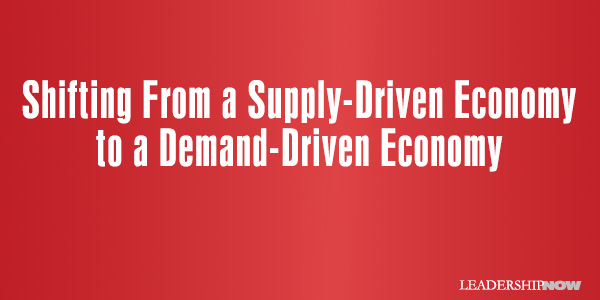 |
 |
11.23.10

Shifting From a Supply-Driven Economy to a Demand-Driven Economy IT was always safe to assume the ever-expanding marketplace would consume everything we produced. But the economic downturn has brought to light, the shift from a supply-driven economy to a demand-driven economy. Authors Rick Kash and David Calhoun point out in How Companies Win that we “have now entered an era of oversupply.” ... Consequently, “organic growth and profitability become increasingly difficult to achieve.” At the same time, “it is imperative that you construct a framework in your company that encompasses and aligns everyone toward meeting not just the current but the latent and emerging demand of your highest-profit customers and consumers.”
IT was always safe to assume the ever-expanding marketplace would consume everything we produced. But the economic downturn has brought to light, the shift from a supply-driven economy to a demand-driven economy. Authors Rick Kash and David Calhoun point out in How Companies Win that we “have now entered an era of oversupply.” ... Consequently, “organic growth and profitability become increasingly difficult to achieve.” At the same time, “it is imperative that you construct a framework in your company that encompasses and aligns everyone toward meeting not just the current but the latent and emerging demand of your highest-profit customers and consumers.”
How Companies Win is a book about learning to understand demand. If you are relying on your customers to tell you what they want it’s too late. You’re playing at best a defensive game because they’ve already told your competitors as well. Getting ahead of the demand “whole it is still forming” is the key. Successful companies are looking at what the demand will be like tomorrow, next year, and five years from now. They get their cues, the authors report, in these ways:
This requires, of course, a new set of skills for leaders to understand the management of demand. Not that supply chain management is no longer needed, it just isn’t the decisive factor it once was, say the authors. To the four P’s of marketing—product, price, place and promotion—they add precision as an important factor in creating the alignment between what you sell and the customers demand. It goes beyond market segments—who is buying—to an analysis of the demand landscape—why customers are buying what they are buying; how they think about their purchasing decision. Society is guiding many innovations and is shaping industries. Businesspeople should keep a focus on demand. 
Posted by Michael McKinney at 04:18 PM
|
BUILD YOUR KNOWLEDGE
 

How to Do Your Start-Up Right STRAIGHT TALK FOR START-UPS 
Grow Your Leadership Skills NEW AND UPCOMING LEADERSHIP BOOKS 
Leadership Minute BITE-SIZE CONCEPTS YOU CAN CHEW ON 
Classic Leadership Books BOOKS TO READ BEFORE YOU LEAD |